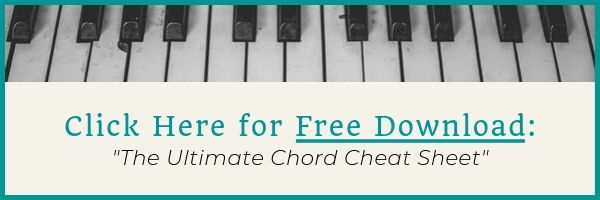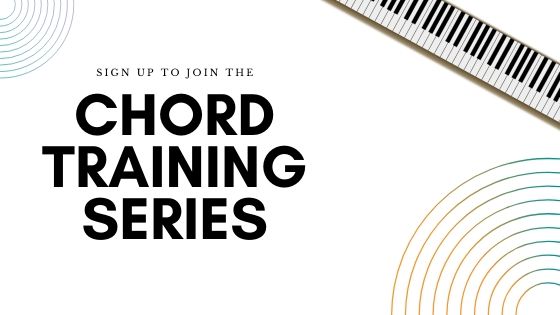How to Play Em Piano Chord
The Em piano chord is a minor chord and is made up of the notes E G B. It's one of the best chords to learn at the beginning of your chord journey and a pretty easy one as there are no black notes.
On this page, you'll learn how to play the E minor chord (and with which fingers) as well as learn the following:
- Em chord finger positions
- Em piano chord notes
- Em/G piano chord
- Em/B piano chord
- Em chord progressions
- what key the E minor chord is in
- and some chord theory
Em Piano Chord Notes
The notes of the Em piano chord are E G B.
You can play these notes in the left hand or the right hand. It's good to keep E as your lowest note in your left hand. The rest of the notes can be played anywhere else above that.
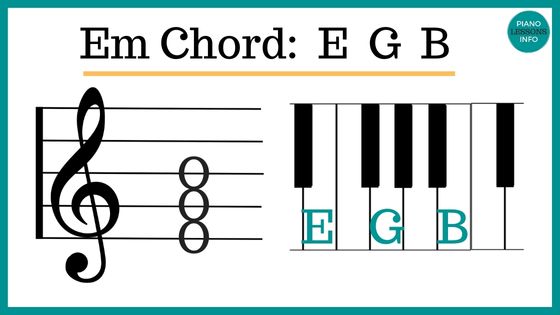 Em Piano Chord Chart
Em Piano Chord ChartVideo: How To Play E Minor Chord
This really quick video will show you how to play the Em chord on piano and where the notes are.
Em Piano Chord Finger Positions
I recommend using the standard finger positions for the E minor chord. This is using fingers 1, 3 and 5 (or thumb, middle finger and pinkie) in either hand.
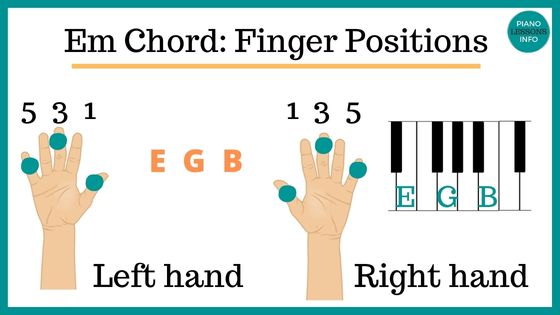
Getting used to playing chords in this position is really great as it'll set you up for success later on in terms of your muscle memory.
Em/G Piano Chord
The Em/G chord is a slash chord and it doesn't mean to play 2 chords at once. What it means is that for Em/G, you play G as the lowest note in your left hand. G is your bass note.
All the rest of the notes of the chord should be played above G.
For example, you could play G in your left hand (note only) and the full Em chord in your right hand.
Em/B Piano Chord
Em/B is another type of slash chord and when you see this, it means to play B in your left hand as the bass note or lowest note you're going to play. Then you play the rest of the Em chords above that.
Em Piano Chord Progression
Chord progressions are a great way to practice a new chord. You can use the following chord progressions to practice the E minor chord (or just enjoy playing it).
Em Chord Progression 1:
Em Am G B
Em Chord Progression 2:
Em C G B
Em Chord Progression 3:
G D Em C
Em Piano Chord Inversions
The E minor chord doesn't have to be played only in root position (E G B). You can play it in different inversions - standard positions you can learn to play chords in.
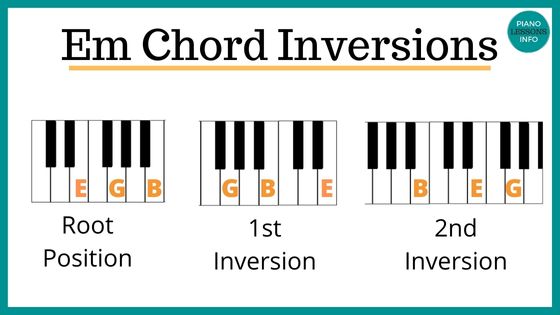
The Em piano chord inversions are:
Root position: E G B
1st inversion: G B E
2nd inversion: B E G
What Key is Em In?
Every major key shares a key signature with a specific minor key. In the case of E minor, it shares a key signature with G major.
G major and E minor have the key signature of 1 sharp - F#.
So when you play in the key of E minor (or G major), just remember to play F# instead of F.
If you need more help understanding key signatures, visit the key signatures page.
Chord Theory For E Minor Chord
Just above we learned that the key signature for E minor is F#. The rest of the notes are white notes. This means we can figure out the E minor scale.
Why is that useful?
One way to work out the notes of a minor chord is to use the minor scale. To make a minor chord, we can use the 1st, 3rd and 5th notes of the minor scale.
For example, E minor scale is:
E F# G A B C D E
The 1st, 3rd and 5th notes of that scale are: E G B.
E G B are E minor chord.
If you need to look up more chords, visit the Piano Chord Charts page or download your own copy below.
Free Download:
Ultimate Chord Cheat Sheet

Subscribe below and get free access to the (printable) Ultimate Chord Cheat Sheet.
FAQ for Em Piano Chord
1. What notes are in the Em (E Minor) piano chord?
1. What notes are in the Em (E Minor) piano chord?
Answer
Question
The Em piano chord consists of three notes: E, G, and B.
2. What is the Em/G chord?
2. What is the Em/G chord?
Em/G is the first inversion of the E minor chord. Instead of the root note E being the lowest note, G is the lowest note. The chord notes are G, B, E. For this chord, the inversion isn’t as important as play G as the bass note.
3. What is the Em/B chord?
3. What is the Em/B chord?
Em/B is the second inversion of the E minor chord. Instead of the root note E being the lowest note, B is the lowest note. The chord notes are B, E, G.
4. How can I use the Em chord in my playing?
4. How can I use the Em chord in my playing?
The Em chord can be used in any piece of music where the harmony supports it. Its somber and introspective sound makes it a great choice for expressing sadness or tension in your music. Use it when playing in the key of G major.
5. How does chord theory apply to the Em chord?
5. How does chord theory apply to the Em chord?
The Em chord is constructed using the root (1), minor third (b3), and perfect fifth (5) of the E minor scale. This arrangement of intervals creates the minor quality of the Em chord.
6. Can the Em chord be used to play a song in the key of E minor?
6. Can the Em chord be used to play a song in the key of E minor?
Absolutely! The Em chord is the i chord (tonic chord) in the key of E minor, meaning it plays a central role in establishing the key of a song or piece in E minor.
Recent Articles
-
Piano Notes Chart
Nov 20, 23 10:21 PM
Find a piano notes chart for treble clef and bass clef notes as well as the different types of notes. -
D Chord on Piano + Diagram, How To & Theory
Oct 24, 23 12:20 AM
Learn how to play the D chord on piano with diagram, fingering, D/A, D/F# and a theory explainer. -
Diminished Piano Chords: Chart & How to Make Them
Oct 09, 23 09:23 PM
Learn the different diminished piano chords and how to make them. Here you'll find both a diminished chord chart and an explanation.
- Home
- 14 Day Chord Challenge
- Em Piano Chord
Free Download:
Ultimate Chord Cheat Sheet

Subscribe below and get free access to the (printable) Ultimate Chord Cheat Sheet.


